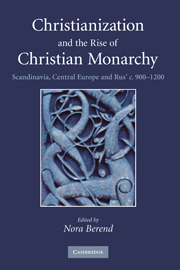Book contents
- Frontmatter
- Contents
- Contributors
- List of maps
- Acknowledgements
- Note
- List of common abbreviations
- Chapter 1 Introduction
- Chapter 2 From paganism to Christianity in medieval Europe
- Chapter 3 The kingdom of Denmark
- Chapter 4 The kingdom of Norway
- Chapter 5 The kingdom of Sweden
- Chapter 6 Bohemia and Moravia
- Chapter 7 The Kingdom of Poland, with an Appendix on Polabia and Pomerania between paganism and Christianity
- Chapter 8 The kingdom of Hungary
- Chapter 9 Rus'
- Index
- References
Chapter 7 - The Kingdom of Poland, with an Appendix on Polabia and Pomerania between paganism and Christianity
Published online by Cambridge University Press: 24 June 2009
- Frontmatter
- Contents
- Contributors
- List of maps
- Acknowledgements
- Note
- List of common abbreviations
- Chapter 1 Introduction
- Chapter 2 From paganism to Christianity in medieval Europe
- Chapter 3 The kingdom of Denmark
- Chapter 4 The kingdom of Norway
- Chapter 5 The kingdom of Sweden
- Chapter 6 Bohemia and Moravia
- Chapter 7 The Kingdom of Poland, with an Appendix on Polabia and Pomerania between paganism and Christianity
- Chapter 8 The kingdom of Hungary
- Chapter 9 Rus'
- Index
- References
Summary
BEFORE CHRISTIANITY: RELIGION AND POWER
A Polish polity appears in the narrative records in the seventh decade of the tenth century, ruled by Prince Mieszko I (before 965–92). He decided to convert in 966 and with this act entered the geopolitical stage of central Europe. The names ‘Poles’ (Polani, Poleni, Poloni) and ‘Poland’ (terra Polanorum, Polenia, Polonia) appear in the written sources about ten years after his death. For the tenth century, therefore, it is better to use the description ‘Piast state’ rather than ‘Poland’, although even this conventional term is merely a matter of convenience since Piast as the founder of the dynasty is mentioned for the first time in the second decade of the twelfth century.
The oldest reference to Mieszko's state may be found in the report of the Jewish merchant Ibrahim ibn Yaqub of Tortosa who in about 965 travelled from Spain to Magdeburg and Prague where he collected information. He called Mieszko the ‘king of the north’ and claimed that his state was the largest in the Slavic area. Ibrahim focused on the military power of Mieszko and on the wealth of natural resources in his country. About 973 Widukind of Corvey also called Mieszko rex Misica/Misaca. Later, however, Thietmar and the Gallus Anonymus treated Mieszko only as dux. Apparently, for Widukind the title ‘king’ indicated sovereign rulers elected by their own people according to the early local tradition.
- Type
- Chapter
- Information
- Christianization and the Rise of Christian MonarchyScandinavia, Central Europe and Rus' c.900–1200, pp. 263 - 318Publisher: Cambridge University PressPrint publication year: 2007
References
- 6
- Cited by

